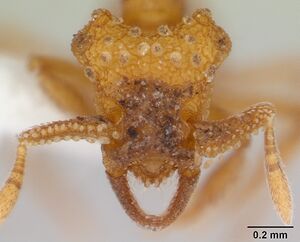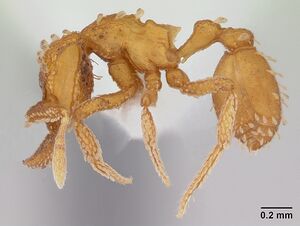Talaridris mandibularis
| Talaridris mandibularis | |
|---|---|

| |
| Scientific classification | |
| Kingdom: | Animalia |
| Phylum: | Arthropoda |
| Class: | Insecta |
| Order: | Hymenoptera |
| Family: | Formicidae |
| Subfamily: | Myrmicinae |
| Tribe: | Attini |
| Genus: | Talaridris |
| Species: | T. mandibularis |
| Binomial name | |
| Talaridris mandibularis Weber, 1941 | |
The sole member of its genus, this ant is a rarely collected rainforest species that has been found in litter and humus.
Photo Gallery
 Full-face view of the queen of Talaridris mandibularis. Photo by Minsoo Dong.
Full-face view of the queen of Talaridris mandibularis. Photo by Minsoo Dong. Talaridris mandibularis. Queen and worker from Iquitos, Peru. Photo by Minsoo Dong.
Talaridris mandibularis. Queen and worker from Iquitos, Peru. Photo by Minsoo Dong.
Identification
Worker and female: Antennae with 7 segments total. Very similar to Rhopalothrix, but with somewhat different mandibles. These are elongate as in Rhopalothrix, but curve dorsad from the plane of the head, finally broadening into an obliquely oriented apical masticatory border with acute and rounded teeth. There are inconspicuous denticles arranged along the inner dorsal margins of the blades also. Of the apical series, the largest acute teeth, one at each end of the series, may correspond to the long, acute subapical and ventral apical teeth forming the "apical fork" of Rhopalothrix, in which case the intervening teeth would represent elaborations of the two intercalary teeth or denticles of Rhopalothrix. In fact, the distinction between these two genera is relatively trivial, and when more species of Rhopalothrix become known, it may well prove advantageous to merge Talaridris with it. (Brown and Kempf 1960)
Distribution
Known from northern South America and Trinidad.
Latitudinal Distribution Pattern
Latitudinal Range: 10.70694444° to 2.016666667°.
| North Temperate |
North Subtropical |
Tropical | South Subtropical |
South Temperate |
- Source: AntMaps
Distribution based on Regional Taxon Lists
Neotropical Region: Brazil, Colombia, Guyana, Trinidad and Tobago (type locality).
Distribution based on AntMaps
Distribution based on AntWeb specimens
Check data from AntWeb
Countries Occupied
| Number of countries occupied by this species based on AntWiki Regional Taxon Lists. In general, fewer countries occupied indicates a narrower range, while more countries indicates a more widespread species. |

|
Estimated Abundance
| Relative abundance based on number of AntMaps records per species (this species within the purple bar). Fewer records (to the left) indicates a less abundant/encountered species while more records (to the right) indicates more abundant/encountered species. |

|
Biology
Castes
Males have yet to be collected.
Worker
Images from AntWeb
   
| |
| Worker. Specimen code casent0178733. Photographer April Nobile, uploaded by California Academy of Sciences. | Owned by MCZ, Cambridge, MA, USA. |
Nomenclature
The following information is derived from Barry Bolton's Online Catalogue of the Ants of the World.
- mandibularis. Talaridris mandibularis Weber, 1941a: 185, figs. 1-3 (w.q.) TRINIDAD. Combination in Basiceros: Baroni Urbani & De Andrade, 2007: 92. See also: Brown & Kempf, 1960: 241.
Unless otherwise noted the text for the remainder of this section is reported from the publication that includes the original description.
Description
Worker
Length 2.8 mm. (of thorax, in straight line from anterior pronotal margin to apex of episternal angles, 0.75 mm.). Head angulate in front view and, excluding mandibles, broader than long, occipital margin broadly concave, corners produced markedly as distinct angles, sides in front of occipital corners laterally expanded as rounded lobes, sides converging from here to mandibles, anterior clypeal margin concave, bounded laterally by rounded lobes; frontal lobes small and convex, only partly covering the antennal fossae; eyes minute, situated on margin of antennal scrobe on posterior half of -head; mandibles porrect, in front view arcuate, narrow, with about six acute denticles on the inner margin, in other views seem to be markedly expanded apically so that the apices of the two mandibles form a basket, each mandible apically with an irregular series of lobes and teeth, consisting basally and ventrally of a bifurcated spine, a diastema, then an acute denticle, followed by a narrow lobe, another denticle, a second narrow lobe, a denticle, and finally a small, acute tooth; antennal scapes strongly elbowed, attached by a distinct pedicel, stout and expanded at the base, extending to the lateral lobes in front of the occiput; terminal funicular joint slightly longer than the preceding joints taken together.
Thorax in profile only very faintly impressed in the pro-mesonotal region but markedly impressed at the meso-epinotal suture, the promesonotum convex; basal surface of epinotum convex, epinotal spines a pair of triangular lamellae continued down the declivous surface on either side; thorax from above nearly two-thirds as broad through pronotum as long to the epinotal spines, the pro-mesonotum convex laterally, epinotal sides sub-parallel, converging dorsally. Petiole strongly pedunculate, mid-ventrally with a small tooth directed anteriorly, node in profile convex, from above slightly longer than wide with sides convex; postpetiole in profile irregularly convex, from above somewhat kidney shaped, being concave where attached to the petiole and convex behind, the anterior part on either side of the concavity being slightly angulate, over twice as wide as the petiolar node, the posterior convexity produced medially as two feeble gibbosities. Gaster ovate, first gastric segment concave anteriorly, covering nearly three-fourths of gaster; sting short, exserted. Legs moderately long and slender, the middle coxae smallest.
Opaque, closely punctate, coarsely reticulate-punctate posteriorly on head, integument partly obscured by an apparent glandular excretion which also covers the mandibles.
Pilosity of numerous coarse hairs which are most numerous and scale-like or flattened-clavate on the appendages and sparse but much larger and squamate on the scapes and body; six of the latter are on the pro-mesonotum in a row on each side, two spring from the petiolar node behind, four similarly on the postpetiole and the gaster is fairly evenly sprinkled with them.
Pale ferruginous, appendages slightly paler than body.
Brown and Kempf (1960) - Holotype worker: TL 3.0, HL 0.70, HW 0.73 (CI 104), ML 0.26 (MI 37), WL 0.73 mm.
A fine median carina runs from posterior clypeal angle to vertex. Eyes minute, hidden from full-face dorsal view by one of the large spoon-shaped hairs on each side of the head. Alitrunk with a broad and deep metanotal groove. Propodeal teeth acutely triangular, lamelliform. Petiole pedunculate, node rounded above, with gently sloping, convex posterodorsal face; node seen from above narrow, rounded in front, longer than broad; peduncle with a stout oblique process at its anteroventral extremity. Postpetiole large, nearly 3 times as broad as petiolar node, subreniform, excised in front; posterior border, though generally convex, has a weak median and two flanking emarginations.
Body densely and finely punctulate-granulose, opaque; occipital area and promesonotum with coarser punctures also, and on the occiput the surface is even slightly rugulose. Head, promesonotum and nodes with a moderate whitish incrustation of hardened material, especially in the punctures; possibly this is a secretion.
Upper surfaces of scapes, lateral surfaces of mandibles, and legs with a covering of small, oval, subappressed squamiform hairs; ground pilosity otherwise obsolete or nearly so. Hairs bordering scapes along its anterior edge spatulate, curved. Large thick, inverted spoon-shaped hairs form a pattern on the head. Similar hairs elsewhere on body (the full complement inferred from a slightly abraded specimen): 1 pair on pronotum; 1 pair on mesonotum; 1 pair on posterior petiolar node (another pair may have been present on the front of the node, now missing); 4 hairs on posterior petiolar node, the middle pair small; about 16 hairs on gastric tergite I, arranged in 4 longitudinal rows; a few smaller hairs on each gastric apical segment; one hair at each tibial apex. Gula with a few slender, curved, truncate hairs. Color sordid yellowish ferruginous.
Queen
Length 3.2 mm. (of thorax, in a straight line from anterior pronotal margin to apex of episternal angles, 0.81 mm.) Similar to the worker with the usual sexual differences. Occipital corners somewhat more acutely angulate. Eyes and ocelli large and prominent, the eyes being on the margin of the antennal scrobes above the fossae and below the lateral lobes of the head. Mandibular structure the same, mandibles meeting also at the expanded apices to form a basket.
Epinotal spines and lamellae as in the worker. Anterior margin of petiolar node less rounded, more angulate.
Brown and Kempf (1960) - Paratype female: TL 3.2, HL 0.75, HW 0.73 (CI 97), ML 0.26 (MI 35), WL 0.83, greatest diameter of compound eye 0.15 mm. In addition to the surprisingly narrow head, the female differs in the usual ways from the worker caste. Alary sclerites with 12 of the thick erect hairs, mostly bordering the dorsal surface, 1 pair discal on the scutum. First gastric tergite with 20 or more of the large hairs.
Type Material
Holotype: One worker taken May 25, 1935, in the foothills north of Tunapuna, Trinidad, B. W. I. by myself (No. 180). The ant was beneath leaves under a bamboo clump in lastro or second growth forest at an elevation of slightly over 200 feet above sea level.
Paratypes (Syntypes): Two workers which I took November 18, 1934, north of Tunapuna (Lat. 100 42' 25" N., Long. 610 23' W.) Trinidad, B. W. I. at an elevation of 1580 feet (No. 3b). These were also under leaves but in the rich forest on top of the ridge separating the Tacarigua and Maracas River valleys.
Gynetype: One dealate female taken by myself June 24, 1936, in virgin rain forest beside the aka River, tributary of the Cuyuni River, British Guiana, (No. 506). The ant was in humus on the roots of a tree about two feet above the ground.
References
- Albuquerque, E., Prado, L., Andrade-Silva, J., Siqueira, E., Sampaio, K., Alves, D., Brandão, C., Andrade, P., Feitosa, R., Koch, E., Delabie, J., Fernandes, I., Baccaro, F., Souza, J., Almeida, R., Silva, R. 2021. Ants of the State of Pará, Brazil: a historical and comprehensive dataset of a key biodiversity hotspot in the Amazon Basin. Zootaxa 5001, 1–83 (doi:10.11646/zootaxa.5001.1.1).
- Brown, W. L., Jr.; Kempf, W. W. 1960. A world revision of the ant tribe Basicerotini. Stud. Entomol. (n.s.) 3: 161-250 (page 241, see also)
- Franco, W., Ladino, N., Delabie, J.H.C., Dejean, A., Orivel, J., Fichaux, M., Groc, S., Leponce, M., Feitosa, R.M. 2019. First checklist of the ants (Hymenoptera: Formicidae) of French Guiana. Zootaxa 4674, 509–543 (doi:10.11646/zootaxa.4674.5.2).
- Weber, N. A. 1941a. Four new genera of Ethiopian and Neotropical Formicidae. Ann. Entomol. Soc. Am. 34: 183-194 (page 185, figs. 1-3 worker, queen described)
References based on Global Ant Biodiversity Informatics
- Brown W. L., Jr. 1949. Revision of the ant tribe Dacetini: IV. Some genera properly excluded from the Dacetini, with the establishment of the Basicerotini new tribe. Trans. Am. Entomol. Soc. 75: 83-96.
- Brown W. L., Jr., and W. W. Kempf. 1960. A world revision of the ant tribe Basicerotini. Stud. Entomol. (n.s.) 3: 161-250.
- Fernández, F. and S. Sendoya. 2004. Lista de las hormigas neotropicales. Biota Colombiana Volume 5, Number 1.
- Franco W., N. Ladino, J. H. C. Delabie, A. Dejean, J. Orivel, M. Fichaux, S. Groc, M. Leponce, and R. M. Feitosa. 2019. First checklist of the ants (Hymenoptera: Formicidae) of French Guiana. Zootaxa 4674(5): 509-543.
- Kempf, W.W. 1972. Catalago abreviado das formigas da regiao Neotropical (Hym. Formicidae) Studia Entomologica 15(1-4).
- Weber N. A. 1941. Four new genera of Ethiopian and Neotropical Formicidae. Ann. Entomol. Soc. Am. 34: 183-194.

